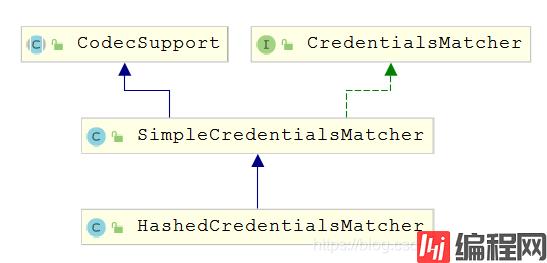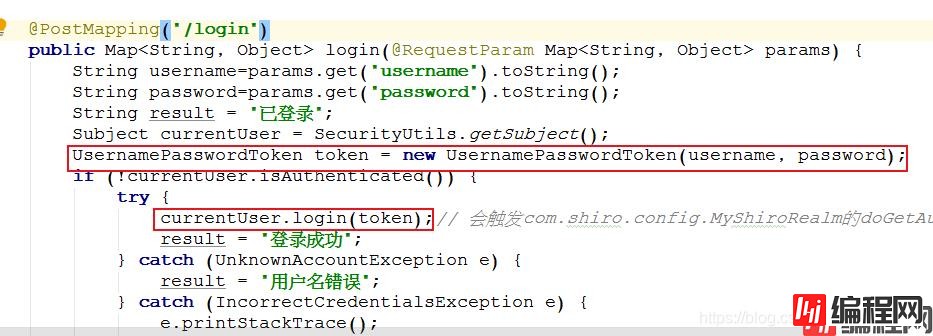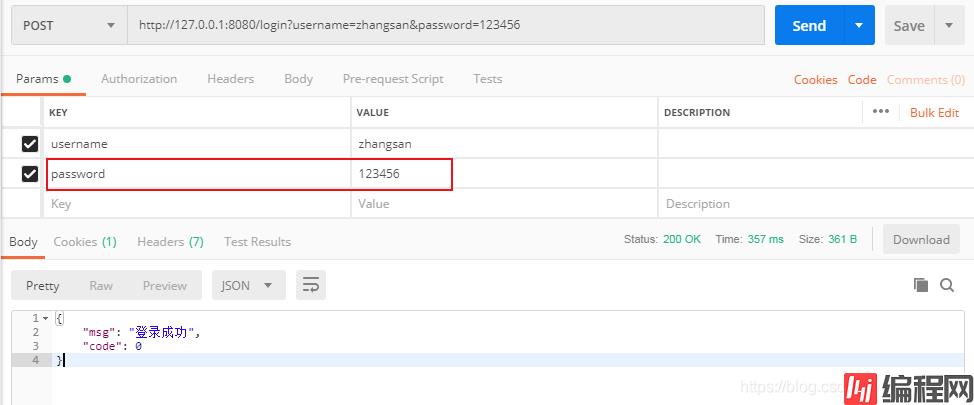Python 官方文档:入门教程 => 点击学习
类图如下: SimpleCredentialsMatcher是明文匹配,也是shrio框架默认的比对方式,网上的例子多是此方式。实际项目中,数据库中的密码一般是密文,此时密码的匹配
类图如下:

SimpleCredentialsMatcher是明文匹配,也是shrio框架默认的比对方式,网上的例子多是此方式。实际项目中,数据库中的密码一般是密文,此时密码的匹配需使用HashedCredentialsMatcher完成。
在controller中通过Subject的login(token)将接收过来用户账号和密码(明文)交给shrio框架,示例代码如下

其次通过HashedCredentialsMatcher告诉shrio使用加密方式;

最后通过AuthorizingRealm,将数据库中获取的密码,告诉shrio框架,shrio处理完成后返回处理结果。

数据库创建表user,结构如下:
CREATE TABLE `user` (
`id` bigint(20) NOT NULL AUTO_INCREMENT,
`name` varchar(50) DEFAULT NULL,
`psw` varchar(200) DEFAULT NULL,
`user_right` varchar(300) DEFAULT NULL,
`create_time` date DEFAULT NULL,
`salt` varchar(100) DEFAULT NULL,
PRIMARY KEY (`id`)
)
在dao完成根据登录名获取实体对象和增加用户两个方法,略过。service代码如下,保存代码时,密码使用sha256加密,盐随机获取20位随机数
@Service("UserService")
public class UserServiceImpl extends ServiceImpl<UserDao, UserEntity> implements UserService {
@Override
public UserEntity getUserByname(String loginName) {
return baseMapper.queryByUserName(loginName);
}
@Override
public boolean save(UserEntity user) {
user.setCreateTime(new Date());
String salt = RandomStringUtils.randomAlphanumeric(20);
user.setPsw(new Sha256Hash(user.getPsw(), salt).toHex());//sha256加密
user.setSalt(salt);
try {
baseMapper.insert(user);
return true;
} catch (Exception e) {
return false;
}
}
}
controller代码如下
@RestController
public class UserController {
@Autowired
private UserService userService;
@PostMapping("/login")
public Map<String, Object> login(@RequestParam Map<String, Object> params) {
String username=params.get("username").toString();
String passWord=params.get("password").toString();
String result = "已登录";
Subject currentUser = SecurityUtils.getSubject();
UsernamePasswordToken token = new UsernamePasswordToken(username, password);
if (!currentUser.isAuthenticated()) {
try {
currentUser.login(token);// 会触发com.shiro.config.MyShiroRealm的doGetAuthenticationInfo方法
result = "登录成功";
} catch (UnknownAccountException e) {
result = "用户名错误";
} catch (IncorrectCredentialsException e) {
e.printStackTrace();
result = "密码错误";
}
}
return R.ok(result);
}
@GetMapping("/loGout")
public void logout() {
Subject currentUser = SecurityUtils.getSubject();
UserEntity user = (UserEntity)currentUser.getPrincipal();
System.out.println(user.getName());
currentUser.logout();
}
@RequestMapping("/user/add")
public String add(@RequestBody UserEntity user) {
userService.save(user);
System.out.println("新增用户");
return "hello";
}
}
使用ShiroConfig 代替xml配置文件方式
@Configuration
public class ShiroConfig {
@Bean
public ShiroFilterFactoryBean shiroFilter(SecurityManager securityManager) {
ShiroFilterFactoryBean shiroFilterFactoryBean = new ShiroFilterFactoryBean();
//设置自定义的securityManager
shiroFilterFactoryBean.setSecurityManager(securityManager);
//设置默认登录的url,身份认证失败会访问该URL
shiroFilterFactoryBean.setLoginUrl("/login");
//设置成功,会访问该url
shiroFilterFactoryBean.setSuccessUrl("/success");
//设置未授权界面,权限认证失败会访问该url
shiroFilterFactoryBean.setUnauthorizedUrl("/notRole");
//进行拦截器配置
Map<String, String> filterChainDefinitionMap = new LinkedHashMap<>();
// <!-- authc:所有url都必须认证通过才可以访问; anon:所有url都都可以匿名访问-->
filterChainDefinitionMap.put("/WEBjars/**", "anon");
filterChainDefinitionMap.put("/login", "anon");
filterChainDefinitionMap.put("/", "anon");
filterChainDefinitionMap.put("/front/**", "anon");
filterChainDefinitionMap.put("/user/add", "perms[add]");
filterChainDefinitionMap.put("/admin/**", "authc");
filterChainDefinitionMap.put("/user/**", "authc");
//主要这行代码必须放在所有权限设置的最后,不然会导致所有 url 都被拦截 剩余的都需要认证
filterChainDefinitionMap.put("/**", "authc");
//配置logout过滤器
filterChainDefinitionMap.put("/logout","logout"); shiroFilterFactoryBean.setFilterChainDefinitionMap(filterChainDefinitionMap);
return shiroFilterFactoryBean;
}
@Bean
public SecurityManager securityManager() {
DefaultWebSecurityManager defaultSecurityManager = new DefaultWebSecurityManager();
defaultSecurityManager.setRealm(customRealm());
return defaultSecurityManager;
}
@Bean
public CustomRealm customRealm() {
CustomRealm customRealm = new CustomRealm();
//SimpleCredentialsMatcher明文匹配,hashedCredentialsMatcher加盐匹配
customRealm.setCredentialsMatcher(hashedCredentialsMatcher());
return customRealm;
}
@Bean
public HashedCredentialsMatcher hashedCredentialsMatcher() {
HashedCredentialsMatcher hashedCredentialsMatcher = new HashedCredentialsMatcher();
hashedCredentialsMatcher.setHashAlgorithmName("SHA-256");
hashedCredentialsMatcher.setHashIterations(1);
return hashedCredentialsMatcher;
}
}
Realm中代码如下:
public class CustomRealm extends AuthorizingRealm {
@Autowired
private UserService userService;
@Override
protected AuthorizationInfo doGetAuthorizationInfo(PrincipalCollection principalCollection) {
//授权部分代码略
return null;
}
@Override
protected AuthenticationInfo doGetAuthenticationInfo(AuthenticationToken authenticationToken) throws AuthenticationException {
String loginName = (String) authenticationToken.getPrincipal();
UserEntity user= userService.getUserByname(loginName);
if (user == null) { // 没找到帐号
throw new UnknownAccountException();
}
// 交给AuthenticatingRealm使用CredentialsMatcher进行密码匹配
SimpleAuthenticationInfo authenticationInfo =
new SimpleAuthenticationInfo(user, user.getPsw(), ByteSource.Util.bytes(user.getSalt()),getName());
return authenticationInfo;
}
测试,使用张三登录


以上就是shrio中hashedCredentialsMatcher密码匹配示例详解的详细内容,更多关于shrio中hashedCredentialsMatcher密码匹配的资料请关注编程网其它相关文章!
--结束END--
本文标题: shrio中hashedCredentialsMatcher密码匹配示例详解
本文链接: https://lsjlt.com/news/137929.html(转载时请注明来源链接)
有问题或投稿请发送至: 邮箱/279061341@qq.com QQ/279061341
2024-03-01
2024-03-01
2024-03-01
2024-02-29
2024-02-29
2024-02-29
2024-02-29
2024-02-29
2024-02-29
2024-02-29
回答
回答
回答
回答
回答
回答
回答
回答
回答
回答
0